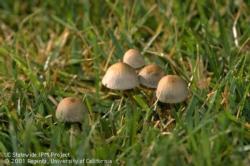Mushrooms in Lawns
-
Mushrooms and Other Nuisance Fungi in Lawns
Mushrooms, sometimes called toadstools, are the visible reproductive (fruiting) structures of some types of fungi. Although the umbrella-shaped fruiting body is the most common and well known, mushrooms display a great variety of shapes, sizes, and colors.
Some other fruiting bodies encountered in lawns include puffballs, stinkhorns, and bird’s nests, descriptive names that reveal the diversity of forms among mushrooms. But regardless of shape, the purpose of all fruiting bodies is to house and then disseminate spores, the reproductive units of fungi.
Many people become concerned when mushrooms appear in their lawns; however, most mushroom-producing fungi in lawns are merely nuisance problems and don’t cause lawn diseases. An exception are fairy-ring mushrooms, which can sometimes cause dead areas of grass by limiting water penetration to turf roots.
Because mushrooms are merely the fruiting bodies of fungi, removing them doesn’t kill the underground mycelia from which they are growing. Picking mushrooms, puffballs, stinkhorns, or other reproductive structures soon after they appear might prevent their spores from spreading to new sites. However, because most spores are windblown long distances, they can easily come into a lawn from neighboring areas. The primary reasons for removing mushrooms from lawns are to keep them away from children and pets and to improve a lawn’s appearance.
A newly revised Pest Note, Mushrooms and Other Nuisance Fungi in Lawns, provides information on managing and identifying many types of lawn mushrooms and is illustrated with photographs of 13 common species. It is available at http://www.ipm.ucdavis.edu/PMG/PESTNOTES/pn74100.html
—Excerpted with modifications from the Pest Note by Michelle LeStrange, UC Cooperative Extension, Tulare Co., mlestrange@ucdavis.edu; Carol A. Frate, UC Cooperative Extension, Tulare Co., cafrate@ucdavis.edu; and R. Michael Davis, Plant Pathology, UC Davis, rmdavis@ucdavis.edu

